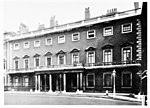Den Norske Klub
1887 establishments in the United KingdomGentlemen's clubs in LondonOrganizations established in 1887Vague or ambiguous time from December 2016

Den Norske Klub (The Norwegian Club) is a social club based in London. It was founded on 17 May 1887. Its members are Norwegians living in London or Britons with a connection to or interest in Norway. It is the oldest club of its kind in the UK and is still an important meeting place for the Norwegian community in London. As a result of DNK's long existence and extensive networks, DNK attracts high caliber speakers and guests to its events including royals, celebrities, business leaders, and members of parliament.
Excerpt from the Wikipedia article Den Norske Klub (License: CC BY-SA 3.0, Authors, Images).Den Norske Klub
St James's Square, City of Westminster Covent Garden
Geographical coordinates (GPS) Address Nearby Places Show on map
Geographical coordinates (GPS)
| Latitude | Longitude |
|---|---|
| N 51.508141666667 ° | E -0.13479166666667 ° |
Address
Naval and Military Club (In & Out)
St James's Square 4
SW1Y 4JU City of Westminster, Covent Garden
England, United Kingdom
Open on Google Maps








